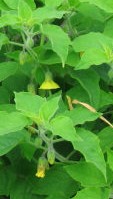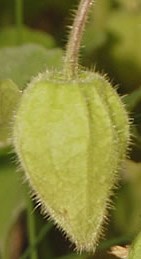 If you are familiar with the cultivated plant Chinese lantern you will recognize its cousin, clammy groundcherry. Both are perennials in the genus Phasalis, produce papery lantern like structures, and spread quickly in a perennial border. The lanterns of clammy groundcherry are yellow, however, instead of orange like those Chinese lanterns, so are less showy and desirable. Native to North America, clammy groundcherry is common in the eastern United States and is found in every state except California and Nevada. It thrives is full sun, fertile to poor, and moist to dry soils that are uncultivated so are often present in shrub and perennial borders.
If you are familiar with the cultivated plant Chinese lantern you will recognize its cousin, clammy groundcherry. Both are perennials in the genus Phasalis, produce papery lantern like structures, and spread quickly in a perennial border. The lanterns of clammy groundcherry are yellow, however, instead of orange like those Chinese lanterns, so are less showy and desirable. Native to North America, clammy groundcherry is common in the eastern United States and is found in every state except California and Nevada. It thrives is full sun, fertile to poor, and moist to dry soils that are uncultivated so are often present in shrub and perennial borders.
 Description: Highly branched stems are hairy and grow 8” to 30” tall. The yellowish-green leaves are alternate, somewhat egg-shaped, and 1-4” long.
Description: Highly branched stems are hairy and grow 8” to 30” tall. The yellowish-green leaves are alternate, somewhat egg-shaped, and 1-4” long.  They are hairy and may have wavy margins. The nodding flowers are borne singly and have yellow petals with purple centers that are not easily seen because the flowers are facing downward. The fruit is a yellow berry encased in a green papery covering that turns yellow as it matures. Deep rhizomes anchor the plants and account for its spreading nature.
They are hairy and may have wavy margins. The nodding flowers are borne singly and have yellow petals with purple centers that are not easily seen because the flowers are facing downward. The fruit is a yellow berry encased in a green papery covering that turns yellow as it matures. Deep rhizomes anchor the plants and account for its spreading nature.
Clammy groundcherry is similar in appearance to smooth groundcherry but can be distinguished from it is hairy leaves and yellow berries. Smooth groundcherry lacks the hairs and has red, orange, or purple mature berries. Virginia groundcherry is also similar to clammy groundcherry but has narrower leaves.

 Control: When plants are young they can be hand pulled or hoed. Once the plants establish their deep growing rhizomes and root system they start spreading and are difficult to eradicate. The whole plant should be dug out taking care to remove all of the rhizome because small pieces left in the soil can grow into new plants. Herbicides are generally effective but in some areas populations have become resistant to glyphosate (contained in herbicides like Roundup) and strong applications may need to be applied more than once.
Control: When plants are young they can be hand pulled or hoed. Once the plants establish their deep growing rhizomes and root system they start spreading and are difficult to eradicate. The whole plant should be dug out taking care to remove all of the rhizome because small pieces left in the soil can grow into new plants. Herbicides are generally effective but in some areas populations have become resistant to glyphosate (contained in herbicides like Roundup) and strong applications may need to be applied more than once.